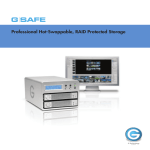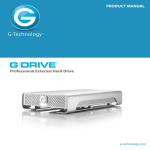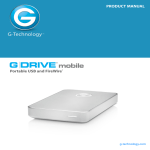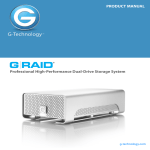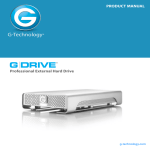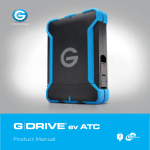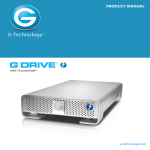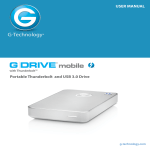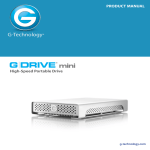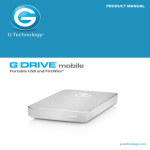Download G-Technology G-RAID mini
Transcript
PRODUCT MANUAL Portable Dual-Drive Storage System g-technology.com Table Table of Contents Welcome to G-RAID mini Table of Contents Safety & General Use Safety Precautions......................................4 Backup Your Data.......................................5 About Your G-RAID mini Introduction.................................................7 What’s in the Box .......................................8 Overview of the Drive ..............................9 System Requirements............................ 10 Disconnect the Drive ............................. 10 Using Your Drive on Mac Easy Installation for Mac....................... 12 Optimize its Performance..................... 13 Activity & Failure LEDs........................... 13 Using RAID Modes Supported RAID Modes........................ 15 The Configurator Utility........................ 16 Configure the RAID Mode.................... 16 Maintenance for Your Drive Initialize Drive for Mac .......................... 20 Restore the Drive Icon........................... 23 Reformat with Partitions....................... 25 Using Your Drive on Windows Windows Use............................................. 30 Cross Platform Use.................................. 31 Support & Warranty Technical Support................................... 35 Limited Warranty..................................... 36 Copyright.................................................... 38 p.2 Safety & General Use Safety Precautions ...................................... p.4 • Backup Your Data ........................................ p.5 • health Safety & General Use Safety Precautions G-RAID mini’s warranty may be void as a result of the failure to respect the precautions listed here. If you detect a problem with your drive, please contact our Technical Support department. If the product is returned with damage caused by improper handling, the warranty will be void and liability will rest with the user. Please read our Limited Warranty. • Servicing: Your drive contains no user-serviceable parts. If it appears to be malfunctioning, have it inspected by a qualified Technical Support representative. • Moisture: Place the device away from moisture or liquids. To reduce the risk of damage, do not expose this drive to rain or moisture. Do not use it in damp or wet conditions. Never place objects containing liquids on the drive as they may spill into its openings. • Ventilation: Place the device in a vented area. The drive should never be placed near or over a radiator or heat source. •T emperature: Do not expose this drive to temperatures outside the range of 5°C to 35°C (41°F to 95°F); or to operational humidity beyond 5-80%, non-condensing, or non-operating humidity beyond 10-90%, non-condensing. Avoid placing your drive near a source of heat, or exposing it to sunlight (even through a window), or in an environment that is too cold or humid. •P hysical Damage: Do not place heavy objects on the drive. Never use excessive force on your drive. p.4 backup Safety & General Use Backup Your Data The disk drive contained in your G-RAID mini is a delicate electronic instrument and is susceptible to damage due to excessive physical shock. Under no circumstances will G-Technology be held liable for the recovery or restoration of lost data. Any loss, corruption or destruction of data while using a G-Technology drive is the sole responsibility of the user. Make Two Backups To help prevent the loss of your data, we highly recommend that you keep TWO copies of your data in separate storage locations. Keep one copy on your G-Technology drive. Keep a second copy on your internal hard drive, another G-Technology drive, or a form of removable storage media. p.5 About Your G-RAID mini • • • • • Introduction ............................................... What’s in the Box .................................... Overview of the Drive ............................. System Requirements ............................. Disconnect the Drive .............................. p.7 p.8 p.9 p.10 p.10 intro About Your G-RAID mini Introduction Thank you for purchasing the G-RAID mini from G-Technology. The G-RAID mini hard drive is a high-speed, low-cost portable RAID designed specifically for professional content creation applications. G-RAID mini features either RAID 0 (performance) or RAID 1 (protected) operation, and high-speed USB 3.0 and FireWire interface. G-RAID mini is the ideal portable storage solution for safe-guarding content transferred from professional tapeless video cameras. Its compact size and tough, all-aluminum enclosure makes it perfect for capturing and editing on the go or working on location. G-RAID mini is capable of delivering an unprecedented 170+ MB/second transfer rate when connected via eSATA in RAID 0 mode. The drive is FireWire bus-powered so you do not need to be connected to AC power. G-RAID mini supports multi-stream HDV, DVCPro™ HD, XDCAM™ HD, ProRes™ 422 and uncompressed SD workflows. p.7 inbox About Your G-RAID mini What’s in the Box The following items are included in the box: • G-RAID mini • (1) USB 3.0 cable (backwards compatible with USB 2.0) • (2) FireWire cables (800; 800 to 400) • Portable carrying case • External DC Power Supply If any items are missing, please contact G-Technology at g-technology.com/support or call (888) 426-5214. p.8 overview About Your G-RAID mini Overview of the Drive This diagram shows the helpful features of your G-RAID mini. There is a Power & Activity LED and a Yellow Drive Failure LED on the front of the unit. (On some models the Drive Failure LED may be RED.) There is a heat-sink and cooling fan on the bottom. Read about LEDs. On the rear of the drive is a high speed USB 3.0 port, two FireWire 800 ports and a DC Power In Connector. p.9 disconnect About Your G-RAID mini System Requirements G-RAID mini supports the folllowing Operating Systems. The drive is set up at the factory for use with Mac OS® X systems, and formatted as ‘HFS+ with Journaling’. • Mac OS 10.5 or higher • Windows XP, Vista or Windows 7 Disconnect the Drive A great feature of G-RAID mini is its ability to connect and disconnect while your computer is running. To prevent failures and/or data loss, it is important to follow the steps below when disconnecting or ‘unmounting’ the drive from your computer. 1. Before disconnecting the drive, unmount the system by simply dragging the G-RAID mini icon to the trash located in the dock. Keyboard shortcut: Select the drive icon and hit Command + E. 2. It is safe to remove the drive from your system when the drive icon is no longer present on your desktop. Helpful links • To use G-RAID mini on Windows, go to Windows Use. • To use G-RAID mini on Mac and Windows together, go to Cross Platform Use. p.10 Using Your Drive on Mac Easy Installation for Mac ......................... p.12 • Optimize its Performance ....................... p.13 • Activity & Failure LEDs ............................ p.13 • install Using Your Drive on Mac Easy Installation for Mac G-RAID mini attaches to your computer via a USB 3.0, or one of two FireWire 800 ports. FireWire 400 connectivity is handled by a 9 to 6 pin cable (included). Choose the connection appropriate for your system and connect G-RAID mini with the matching supplied cable. The unit is bus powered via FireWire so no AC power is needed. However, if no FireWire power is available, the included power supply can be used. Simply connect the power cable to the unit and plug the power supply into a surge protector or wall outlet. The drive will automatically mount on the desktop if you are running Mac OS X. p.12 optimize Using Your Drive on Mac Optimize its Performance G-RAID mini can be connected to any Mac or Windows machine equipped with a USB 3.0 port, FireWire 800, or FireWire 400. For maximum performance, G-RAID mini should be connected via USB 3.0 or FireWire 800. Activity & Failure LEDs G-RAID mini contains LEDs that describe the following operations: System Boot Up, System Activity, Disk Activity and Disk Drive Failure. The following table explains the meaning of each combination of LEDs on the drive. The Activity light will glow when power is applied via the FireWire ports. It will flash brighter as data is transferred to or from the hard drive. The Failure light will warn you in the event of a disk drive failure. In the event of a disk drive failure, the yellow Drive Failure LED located behind the front panel will illuminate. • If configured in fail-safe RAID 1 mode, all the data stored on the system is intact. • If configured in RAID 0 mode, all data will be lost. Please contact our Technical Support for help if the Drive Failure LED is lit. p.13 Using RAID Modes Supported RAID Modes ....................... p.15 • The Configurator Utility ........................ p.16 • Configure the RAID Mode .................... p.16 • raid01 Using RAID Modes Supported RAID Modes G-RAID mini ships from the factory in RAID 0 mode, and for use with Mac OS X systems. The drive can be configured in RAID 0 (Performance) mode or RAID 1 (Protected) mode. The following table explains the advantages and disadvantages for each RAID level. To change the RAID mode of the G-RAID mini, follow the steps in Configure the RAID Mode. RAID 0 (Performance) G-RAID mini ships in RAID 0 (Performance) mode. This RAID mode has 100% storage capacity and is ideal for video editing. In RAID 0, data is split between the the two drives for increased performance. RAID 1 (Protected) RAID 1 is great for protection and security of data, making it ideal for sensitive data rather than large amounts. In RAID 1, the array will be at 50% of its total capacity as the same data is written to both drives simultaneously. p.15 configure Using RAID Modes The Configurator Utility The G-Technology Configurator is used to change the RAID level of your G-RAID mini. You can use either USB 3.0 or FireWire 800 with Configurator. The utility is available on the enclosed CD or you can download it from the G-Technology website at http://www.g-technology/support If you download the Configurator, you should launch it directly from the mounted Disk Image. Configure the RAID Mode It is easy to configure the RAID mode with the following steps. NOTE: Changing the RAID level will erase all data on the drive. Be sure all the material you want to save is backed up to a separate disk. 1. Launch the G-Technology Configurator utility. A dialog window will ask you to disconnect all other external hard disks from your computer. This is important to ensure the Configurator does not affect other FireWire or USB devices on your system. p.16 Using RAID Modes 2. Click on the Continue button. A window will appear telling you that Configurator is searching for the G-RAID mini. 3. Once the utility finds your G-RAID mini, the following window will appear. Select the RAID 1 (Protected) or RAID 0 (Performance) radio button. Then click the Configure button to continue. 4. Two Warning windows will appear, letting you know that the following step will erase all of your data. Click the OK/Yes buttons to continue. p.17 Using RAID Modes 5. A window will appear telling you the configuration is in progress. The next window will confirm that your G-RAID mini is configured in RAID 1 or 0 mode. 6. Changing the RAID mode of G-RAID mini will require you to re-initialize the disk with the Disk Utility application. The Disk Insertion dialog below should appear. Click the Initialize button to launch Disk Utility. Go here for the simple steps to initialize G-RAID mini for use with Mac. NOTE: If the Disk Insertion dialog does not appear, go to Application> Utilities and open the Disk Utility program. Once Disk Utility is open, you are ready to initialize and partition G-RAID mini for use with Mac. p.18 Maintenance for Your Drive Initialize Drive for Mac ........................... p.20 • Restore the Drive Icon ............................ p.23 • Reformat with Partitions ......................... p.25 • initialize Maintenance for Your Drive Initialize Drive for Mac G-RAID mini was factory-formatted for use or ‘initialized’ for Mac OS X. You can reinitialize if you¹d like to quickly erase the contents of the drive, or if you reconfigure the RAID mode. Here are the steps. 1. First, open the Disk Utility program. This application is located on your hard drive under Applications/Utilities/Disk Utility. The window below will appear. Your G-RAID mini will be displayed in the left-hand column. 2. Select the G-RAID mini by clicking its drive icon in the left-side column. Information about the drive willl be displayed at the bottom of the window. 3. Select the Erase tab to view the formatting options. By default, the Format pop-up menu is set to the Mac OS Extended (Journaled) option. p.20 format Maintenance for Your Drive 4. Choose the Format option that you prefer. • Mac OS Extended (Journaled): Use this format if you intend to use the drive for Time Machine or to create a separate bootable installation of OS X. • Mac OS Extended: Use this format for best performance and media storage. To select, click the Format pop-up and its option to Mac OS Extended. 5. Click the Erase button in the lower right corner of the window. A dialog box will appear asking if you want to erase the G-RAID mini partition. p.21 Maintenance for Your Drive WARNING: THIS NEXT STEP WILL ERASE ALL DATA ON YOUR DRIVE. 6. Click on the Erase button to continue. A progress bar in the lower right corner of the window will show the progress of the disk’s reformatting. 7. After the drive is reinitialized, you should automatically see the Time Machine dialog box. • Click the Use as Backup Disk button if you want to use the drive with Time Machine. • Click the Don’t Use or Decide Later button if you do not want to use Time Machine at this point. 8. Quit the Disk Utility program. After reinitializing the drive, the custom icon for G-RAID mini has been erased. You can optionally restore this icon with the steps on the next page. p.22 restore Maintenance for Your Drive Restore the Drive Icon If the G-RAID mini drive icon was erased during the reinitializing process (see previous section), you can restore the icon with the following easy steps. NOTE: This process is not required for the operation of G-RAID mini. However, it will make your drive’s appearance on the computer desktop look nicer and more accurate. 1. To get the G-Technology icon package, go to www.g-technology.com/support and navigate to your product. There will be a link to download the icons. 2. Once downloaded, it should automatically open the G-Technology Icons folder as shown below. If not, double-click the Zip file to open. Next, double-click the DMG file to open the G-Technology Icons package. 3. Click to select the drive icon for G-RAID mini in the package window. Press Command+C to copy the icon. (below) p.23 Maintenance for Your Drive 4. Select the G-RAID mini icon on your desktop and press Command+I. This opens its Get Info window. (below left) 5. Select the default icon in the Get Info window. (below left) 6. Press Command+V to paste the custom G-RAID mini icon into the Get Info window. (below right) The icon for your G-RAID mini has been restored and you can close the Get Info window. Your drive is now fully ready for use! p.24 multiple Maintenance for Your Drive Reformat with Partitions ‘Partitioning’ a hard drive is the process of dividing a hard drive into separate, discrete sections called ‘volumes’. Each volume works like a separate disk. You can create up to 16 different partitions on a hard drive in OS X and each partition can be a different size and format. With hard drives getting bigger, it is useful to partition your hard drive so sections of its space can be used for different purposes. For instance, segment user data from backup data, set up a multi-boot environment with different Operating Systems or create a dedicated capture scratch disk for programs like Final Cut Pro. The following steps will guide you through this simple process of partitioning your drive. In this example, we will partition a 500 GB G-RAID mini connected via FireWire. The steps will be identical for your drive, only the name may be different. 1. First, open the Disk Utility program. This application is located on your hard drive under Applications/Utilities/Disk Utility. The window below will appear. Your G-Technology drive will be displayed in the left-hand column. p.25 Maintenance for Your Drive 2. Select the FireWire or USB icon – not the G-Technology drive icon – by clicking it in the left-side column. 3. Click on the Partition button in the main window. 4. Select the number of partitions you would like from the Volume Scheme menu. Below, we have selected ‘2 Partitions’ to create two partitions. p.26 Maintenance for Your Drive 5. Click on the first partition in the Volume Scheme area. Your partition will be highlighted by a blue bounding box. • In the Name field, type a name for the partition. • From the Format menu, choose your desired disk format. If you will use your drive primarily on Mac OSX, it is recommended to use Mac OS Extended or Mac OS Extended (Journaled). For info about formats, go here. • In the Size field, type in a size for the partition. Alternately, you can drag the bar in between each partition to quickly change the size. 6. Repeat this process for each partition you have created. 7. Click the Apply button in the lower right corner of the window. A dialog box will appear asking if you want to erase the G-Technology drive partition. WARNING: THIS NEXT STEP WILL ERASE ALL DATA ON YOUR DRIVE. p.27 Maintenance for Your Drive 8. Click on the Partition button to continue. A progress bar in the lower right corner of the window will show you the progress of the disk’s reformatting. 9. When partitioning is complete, the multiple partitions will be displayed in the left-hand panel of Disk Utility. 10. Quit the Disk Utility program. After reinitializing the drive, the custom icon for the G-Technology drive has been erased. You can optionally restore this icon to each partition with the steps on this page. 11. The multiple partitions of the G-Technology drive will be displayed on the desktop. Your drive is now setup with two or more partitions and ready for use. p.28 Using Your Drive on Windows Windows Use ............................................... p.30 • Cross Platform Use .................................... p.31 • winuse Using Your Drive on Windows Windows Use G-RAID mini is set up at the factory for use with Mac OS X systems. A simple initialization will prepare your drive for use with Windows XP, Vista and Windows 7 systems. For helpful information on configuring and using your drive with Windows, please visit www.g-technology.com/support p.30 crossplat Using Your Drive on Windows Cross Platform Use You can set up G-RAID mini for use on both Windows and Mac system by formatting the drive as ‘FAT32’. To do this, use the Disk Utility application and format the drive to MS-DOS (FAT), also known as FAT32. 1. First, open the Disk Utility program. This application is located on your hard drive under Applications/Utilities/Disk Utility. The window below will appear. Your G-RAID mini will be displayed in the left-hand column. 2. Select the G-RAID mini by clicking on its drive icon in the left-side column. Information about the drive will be displayed at the bottom of the window. 3. Select the Erase tab to view the formatting options. By default, the Format pop-up menu is set to the Mac OS Extended (Journaled) option. p.31 Using Your Drive on Windows 4. Select MS-DOS File System from the Format pop-up menu. This will format to FAT32. NOTE: You may need to rename the drive because FAT32 does not support more than 11 letters in the drive name. WARNING: THIS NEXT STEP WILL ERASE ALL DATA ON YOUR DRIVE. 5. Click the Erase button in the lower right corner of the window. A dialog box will appear asking if you want to erase the G-RAID mini partition. p.32 Using Your Drive on Windows 5. Click the Erase button. A progress bar in the lower right corner of the window will show the progress of the disk’s reformatting. Your drive will be formatted to its full capacity as FAT32. 6. Quit the Disk Utility program. You are finished! 7. After reinitializing, the custom icon for the G-RAID mini will be erased. No icons are available for FAT32. With this format, you will be able to read/write on Windows XP, Vista, and Windows 7 and on Mac OS X machines. Limitations with FAT32 There are some limitations when using FAT32. The ‘MS-DOS File System’ cannot write files over 4 GB. If you are working with files over 4 GB, you may want to choose a software option like MacDrive, www.macdrive.com. MacDrive is Windows software that enables you to mount Mac formatted drives on your Windows computer. NOTE: You could format your drive on a Windows machine FAT32. However, Windows currently limits FAT32 partitions to only 32GB in size. p.33 Support & Warranty Technical Support ..................................... p.35 • Limited Warranty ...................................... p.36 • Copyright ..................................................... p.38 • techsupp Support & Warranty Technical Support Thank you for purchasing G-RAID mini. If you have any comments or questions about this manual or the product, please let us know! G-Technology appreciates and values its customers, striving to give you the finest service and support. If you encounter any difficulties while installing or using G-RAID mini, please contact G-Technology Technical Support at g-technology.com/support. Helpful information for support When contacting Technical Support, it’s best to be in front of your computer and have the following information available: • Your G-RAID mini serial number (on bottom of unit) • Operating System and version • Computer brand and model • List of other devices attached to your computer p.35 warranty Support & Warranty Limited Warranty HGST, a Western Digital Company (“HGST”) Including G-Technology for External Hard Disk Drives What does this limited warranty cover? This Limited Warranty applies to new HGST products purchased from an authorized HGST dealer by the original purchaser for normal use and not for resale. HGST warrants that a covered product is free from defects in materials and workmanship, with the exceptions stated below. How long does limited warranty coverage last? This limited warranty lasts for 1 year, 2 years, 3 years or 5 years, or a fixed period from date of purchase, depending on when and where it was originally purchased. To determine the warranty specifically for your product, visit www.g-technology.com. A valid proof of purchase may be required to prove eligibility. If you do not have a valid proof of purchase, the limited warranty period will be measured from the date of sale from HGST to the authorized distributor. What does this limited warranty not cover? The limited warranty does not cover damage resulting from commercial use, misuse, accident, modification or alteration to hardware or software, tampering, unsuitable physical or operating environment beyond product specifications, improper maintenance, or failure caused by a product for which HGST is not responsible. There is no warranty of uninterrupted or error-free operation. There is no warranty for loss of data—you must regularly back up the data stored on your product to a separate storage product. There is no warranty for product with removed or altered identification labels. HGST DOES NOT PROVIDE ANY OTHER WARRANTIES OF ANY KIND, INCLUDING, BUT NOT LIMITED TO, THE IMPLIED WARRANTIES OR CONDITIONS OF MERCHANTABILITY AND FITNESS FOR A PARTICULAR PURPOSE. SOME JURISDICTIONS DO NOT ALLOW THE LIMITATION OF IMPLIED WARRANTIES, SO THIS LIMITATION MAY NOT APPLY TO YOU. HGST is not responsible for returning to you product which is not covered by this limited warranty. p.36 Support & Warranty What must you do? If you are having trouble with a product, before seeking limited warranty service, first follow the troubleshooting procedures that HGST or your reseller provides. To obtain limited warranty service, you must first obtain a Return Materials Authorization (RMA) and ship-to address by contacting G-Technology at http://www.g-technology.com/support. Please follow the instructions found on the website. You must return the covered hard disk drive using approved packaging to our logistics center. You must pay any associated transportation charges, duties and insurance in shipping the drive to our logistics center. You should remove all personal information from the product prior to its return. What will HGST do? HGST will replace the drive with a functionally equivalent replacement product, transportation prepaid. HGST may replace your product with a product that was previously used, repaired and tested to meet HGST specifications. You receive tile to the replaced product at delivery to carrier at HGST shipping point. You are responsible for importation of the replaced product, if applicable. HGST will not return the original drive to consumers; therefore, the consumer is responsible for moving data to another media before returning. Data Recovery is not covered under this warranty and is not part of the warranty returns process. HGST warrants that the replaced products are covered for the remainder of the original product warranty or 90 days, whichever is greater. How is our liability limited? HGST AND ITS AFFILIATES, SUPPLIERS, DISTRIBUTORS, AND RESELLERS ARE NOT LIABLE FOR ANY OF THE FOLLOWING: 1) THIRD-PARTY CLAIMS AGAINST YOU FOR DAMAGES (OTHER THAN BODILY INJURY INCLUDING DEATH AND TANGIBLE PERSONAL PROPERTY; 2) LOSS OF, OR DAMAGE TO, YOUR DATA; OR 3) SPECIAL, INCIDENTAL, OR INDIRECT DAMAGES OR FOR ANY ECONOMIC CONSEQUENTIAL DAMAGES (INCLUDING LOST PROFITS OR SAVINGS), EVEN IF INFORMED OF THE POSSIBILITY. SOME JURISDICTIONS DO NOT ALLOW LIMITATION OF LIABILITY, INCIDENTAL DAMAGES, OR CONSEQUENTIAL DAMAGES, SO THE ABOVE LIMITATIONS MAY NOT APPLY TO YOU. How do local laws apply? THIS LIMITED WARRANTY GIVES YOU SPECIFIC LEGAL RIGHTS, AND YOU MAY ALSO HAVE OTHER RIGHTS WHICH VARY FROM JURISDICTION TO JURISDICTION. p.37 copyright Support & Warranty CAPACITY DEFINITION AND DISCLAIMER For G-Technology products 1TB or greater: “One gigabyte (GB) is equal to one billion bytes and one terabyte (TB) equals 1,000 GB (one trillion bytes). Accessible capacity will vary from the stated capacity due to formatting and partitioning of the hard drive, the computer’s operating system, and other factors” For G-Technology products less than 1TB: “One gigabyte (GB) is equal to one billion bytes when referring to hard drive capacity. Accessible capacity will vary depending on the operating environment and formatting.” Copyright One gigabyte (GB) is equal to one billion bytes when referring to hard drive capacity. Accessible capacity will vary depending on the operating environment and formatting. Design by G-Technology in California. G-RAID and G-Technology are trademarks of HGST, a Western Digital company. Apple, Mac, MacBook Pro, FireWire, Time Machine and the Mac logo are trademarks of Apple, Inc. Microsoft, Windows, Windows Vista and Windows XP are trademarks or registered trademarks of Microsoft Corporation in the US and/or other countries. Other trademarks are the property of their respective owners. ©2013 G-Technology. All rights reserved. R0 01/13 p.38







































